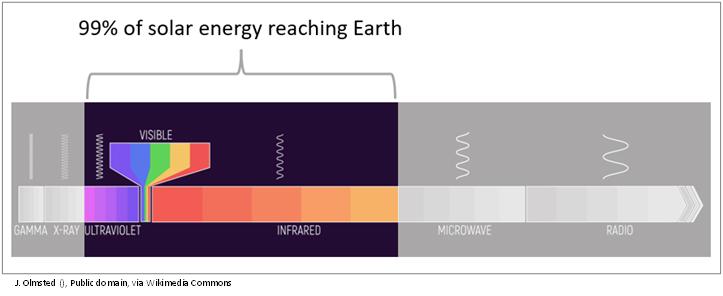Winter 2024
What is Helpful for a Gardener to Know About Light?
by Monika Witte

What impact does the solar radiation that lands on the earth’s surface have on plants? First, we all know that plants produce their own food using photosynthesis. Also, the warming soil in spring, encouraging seeds to germinate and plants to grow, results from the increasing amount of radiation occurring in the spring. The cooling soil and reduced light in the fall are signals for plants to enter dormancy.
What is light, from the perspective of a gardener?
Solar radiation includes a spectrum ranging from very high energy gamma and x-rays down to low energy radio waves. The atmosphere reflects, absorbs, or scatters most of this incoming radiation, and in particular, ozone absorbs most of the harmful ultraviolet (UV) radiation.

The solar radiation that actually lands on plants and their surrounding soil is 99% in the ultraviolet (UV), visible, and infrared (IR) radiation wavelengths. The ultraviolet (UV) radiation that reaches the earth’s surface is a tiny portion of this, which is fortunate because it is damaging. The visible light reaching the earth is what we think of as rainbow colors and light; it comprises more than 40% of the solar radiation reaching the earth and is required for photosynthesis. The remaining radiation is infrared (IR), which accounts for over 50% of the solar radiation that makes it to the earth and provides needed warmth for the air and soil.
During the day, the peak warmth lags behind the peak visible light. That is to say, the peak visible light happens when the sun is directly overhead, around noon. The peak warmth happens a few hours later, in the afternoon. This is why the afternoon full sun is considered “hotter” than the morning sun, even though the amount of visible light may be the same at 10 a.m. and 2 p.m.
Plants have evolved to take advantage of available light (such as large leaves in the shade) and to protect themselves from too much light (such as thick skin on leaves to protect from UV.)
Plants make their own food
Plants produce their own food from ingredients that they obtain from the air (carbon and oxygen), the soil (hydrogen and oxygen), plus sunlight. Without sunlight, plants will starve. Nutrient-rich soil, or fertilizers, won’t help provide these three (C, H, and O) essential nutrients.
While carbon, hydrogen, and oxygen are the nutrients that play an obvious part in the photosynthesis chemical equation, other nutrients also play critical roles. In particular, nitrogen, phosphorus, and potassium (the well-known NPK) help with the plant structure, enabling the plant to perform photosynthesis. Nitrogen makes up part of the chlorophyll pigment molecule and also makes up the required proteins and enzymes. Phosphorus is part of the energy transport system in the plant. If phosphorus is limited, the energy needed to process the carbon won’t be available, resulting in reduced photosynthesis. Potassium helps to control guard cells, which control the opening and closing of the stomata. Stomata are tiny openings in a leaf's surface that allow carbon dioxide (CO2) to enter and water vapor to exit the leaf. Other nutrients also play essential roles, allowing plants to perform photosynthesis. All of these are essential, and photosynthesis would not be possible without them.
Understanding the impact of light can help with diagnosing plant problems
As UC Master Gardeners, we learned that plant problems can fall into two main categories: abiotic and biotic. Abiotic problems include those related to the environment (soil, light, and temperature) and what has been done to the plant (care and maintenance.) Biotic issues stem from something that is alive (insects, mites, pests) or a disease. And of course, any damage or stress could be a result of a single issue or a combination of problems.
If we can learn to understand when too much or too little light is or isn’t a problem, then solving diagnostic issues can be simplified, at least a little bit.
The Capture the Light recorded webinar walks through some of the issues related to too much or too little light.
A handout with resources is also available.
